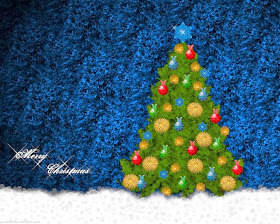When I was a kid, decorating the Christmas tree consisted of
winding a string of lights around the (real) tree, randomly tossing a
hodge-podge of ornaments on, then throwing wads of tinsel at it. And it was
pretty. I mean, it’s a Christmas tree covered in lights, ornaments, and tinsel;
how bad could it be? But as an adult, I’ve learned that there are ways to get
that Martha Stewart polish that really don’t take much effort.
So at the risk of sounding a bit snooty and know-it-all, I
am passing along the lessons I have learned over the years. Feel free to take
my advice or not; I’m sure your tree will be lovely no matter how you decorate
it.
Lights Go on the
Inside
When I was first married, my husband and I disagreed on the
white vs. colored lights issue. He won, mostly because I had enough colored
lights for a 3-foot tree and he had enough white lights for a 7-foot tree. (Honestly,
he had enough lights for half a dozen 7-foot trees.) But what I learned from
him about Christmas tree lights more than made up for losing that battle. He
taught me the trick of burying the lights deep in the branches of the tree
rather than simply wrapping them around at the tips. It takes a lot more time
and requires a lot more lights, but the results give a depth of illumination
that sets off the ornaments and gives the tree a beautiful glow that seems to
come from deep within.
If you opt for a pre-lit artificial tree, as we recently
did, be sure to get one with lights buried deep inside the branches. It’s well
worth the extra cost.
Little on the Top, Big
on the Bottom
No matter what type of Christmas ornaments you use, be it strictly
glass balls or everything from kids’ creations to German blown-glass figurines,
make sure they aren’t all the same size. Decorating a tree with similarly-sized
ornaments all over makes it look disproportionate and top-heavy. If you already
have a collection of various sizes, be sure to put the smallest ones at the top
and the largest ones at the bottom. Like the magically growing Christmas tree
in the Boston Ballet’s Nutcracker, this creates an optical illusion that makes
your tree seem bigger than it really is.
This trick works best if you have similar types of ornaments
in different sizes. For example, we use glass icicles all over our tree, and we
have three sets: tiny, medium, and large. The tiniest ones dangle off the top
branches, the largest nearly brush the floor at the bottom, and the medium ones
fill out the middle. Ditto for our collection of various-sized snowflakes. The
easiest type of ornament to do this with is the standard glass balls, which are
available in many sizes. But if you have an eclectic collection of styles and
shapes of ornaments, just put the smallest at the top and let them grow in size
as you move toward the bottom.
Fill the Empty Space,
Not the Empty Branch
This is a trap that is very easy to fall into, especially
with a real tree. You see an empty space so you hang an ornament on the branch
right in the middle of that space. But unless that ornament is a feather, it’s
going to weigh the branch down and hang lower than where you put it. So fill
spaces by hanging an ornament above the gap, let it settle, then see if it’s
still in the right place. Heavier ornaments, obviously, will dangle lower than
light ones; be sure to compensate for this. With an artificial tree, you can
often bend the branches to tweak the ornament into exactly the right place; it’s
a bit pickier with a real tree. Hanging the heavier ornaments first then
filling in with lighter ones can make this technique easier.
Let ‘Em Dangle
Most ornaments are designed to dangle from a hook or loop of
wire or thread; the crucial word being “dangle.” An ornament that’s resting
awkwardly against a branch or hanging crooked because it’s bumping into
something doesn’t look as nice as one that’s hanging freely. Adjust the
placement of dangling ornaments so they aren’t propped against anything else. This
is especially important for long or large ornaments, or anything with vertical
lines. And it will allow glass and shiny ornaments to move slightly, making the tree's lights seem to twinkle warmly.
Don’t Overdo It
Finally, don’t pack on so many ornaments that you can hardly
see the tree. This can be a hard rule to follow – I know it is for me! Every
year we add another ornament or two to our collection, and it breaks my heart
to not use any of them. But who says ornaments can only go on trees? I hang a
few on the evergreen wreath inside the front door; you can make a nest of small
ornaments around the base of a candle; tuck a few in a bowl of candy kisses;
put them on an advent wreath; or strew them among some greenery on the mantel.
But however you decorate your Christmas tree, following
these rules or not, it will be beautiful. Like babies and brides, Christmas
trees are always beautiful by definition.











No comments:
Post a Comment